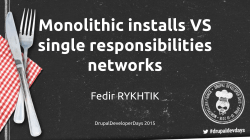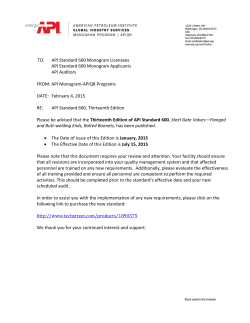
A pattern language for microservices
Decompose that WAR! A pattern language for microservices Chris Richardson Author of POJOs in Action Founder of the original CloudFoundry.com @crichardson chris@chrisrichardson.net http://plainoldobjects.com http://microservices.io @crichardson Presentation goal Why patterns and pattern languages? A pattern language for microservices @crichardson About Chris @crichardson About Chris Founder of a startup that’s creating a platform for developing event-driven microservices @crichardson For more information https://github.com/cer/event-sourcing-examples http://microservices.io http://plainoldobjects.com/ https://twitter.com/crichardson @crichardson Agenda Why a pattern language for microservices? Core patterns Deployment patterns Communication patterns @crichardson In 1986… http://en.wikipedia.org/wiki/Fred_Brooks @crichardson Yet almost 30 years later developers are still passionately arguing over “silver bullets” @crichardson Suck/Rock Dichotomy JavaScript vs. Java Spring vs. Java EE Functional programming vs. Object-oriented Containers vs. Virtual Machines http://nealford.com/memeagora/2009/08/05/suck-rock-dichotomy.html @crichardson Gartner Hype Cycle It’s awesome It’s not awesome Trade-offs understood http://upload.wikimedia.org/wikipedia/commons/b/bf/Hype-Cycle-General.png @crichardson How we make decisions Rationalize with our intellect Decide using emotions http://en.wikipedia.org/wiki/Mahout @crichardson We need a better way to discuss and think about technology @crichardson What’s a pattern? Reusable solution to a problem occurring in a particular context @crichardson The structure of a pattern = Great framework for discussing and thinking about technology @crichardson The structure of a pattern Name Context aka the situation Problem (conflicting) issues etc to address Forces Solution Resulting context Related patterns @crichardson Benefits Resulting context Drawbacks Issues to resolve @crichardson Alternative solutions Related patterns Solutions to problems introduced by this pattern @crichardson Pattern language A collection of related patterns that solve problems in a particular domain Relationships Pattern A results in a context that has a problem solved by Pattern B Access to Water Promenade Local townhall Patterns A and B solve the same problem Intimacy gradient Pattern A is a specialization of pattern B Light on two sides http://en.wikipedia.org/wiki/A_Pattern_Language Meta-pattern Problem: How to talk/reason about technology? Context: Emotional software development culture Solution: Use the pattern format Benefit: More objective Drawback: Less exciting Related patterns: It’s awesome! @crichardson Work in progress Motivating Pattern Solution Pattern Solution A Solution B General Specific Service-perContainer Deployment Service-per-VM Multiple Services per host Single Service per Host Core Monolithic architecture Microservice architecture Partitioning API gateway Communication Server-side discovery Client-side discovery Style Messaging Remote Procedure Invocation Service registry Self registration Discovery 3rd party registration @crichardson Agenda Why a pattern language for microservices? Core patterns Deployment patterns Communication patterns @crichardson @crichardson Let’s imagine you are building an online store Browser/ Client REST/JSON HTML StoreFrontUI Product Info Service Recommendation Service SQL Database Review Service Order Service @crichardson Problem: what’s the deployment architecture? @crichardson Forces There is a team of developers that must be productive The application must be easy to understand and modify Do continuous deployment Run multiple instances for scalability and availability Use emerging technologies (frameworks, programming languages, etc) @crichardson Pattern: Monolithic architecture WAR/EAR StoreFrontUI HTML Browser/ Client REST/JSON Product Info Service Recommendation Service Simple to develop test deploy scale MySQL Database Review Service Order Service Tomcat @crichardson Examples everywhere @crichardson But when the application is large … @crichardson Intimidates developers @crichardson Obstacle to frequent deployments Need to redeploy everything to change one component Interrupts long running background (e.g. Quartz) jobs Increases risk of failure Eggs in one basket Fear of change Updates will happen less often - really long QA cycles e.g. Makes A/B testing UI really difficult @crichardson Overloads your IDE and container Slows down development @crichardson Obstacle to scaling development I want to update the UI But the backend is not working yet! Lots of coordination and communication required @crichardson Requires long-term commitment to a technology stack @crichardson Pattern: Microservice architecture @crichardson Apply functional decomposition X axis - horizontal duplication Sc Z ax is Scale by splitting different things ale - d by ata sp pa th litt rtit in in ion gs g sim ing ila r Y axis functional decomposition @crichardson Microservice architecture Browse Products UI Product ProductInfo Info Service Checkout UI Recommendation Service Order management UI Review Service Account management UI Order Service Apply X-axis and Z-axis scaling to each service independently @crichardson Examples http://techblog.netflix.com/ ~600 services http://highscalability.com/amazon-architecture 100-150 services to build a page http://www.addsimplicity.com/downloads/ eBaySDForum2006-11-29.pdf http://queue.acm.org/detail.cfm?id=1394128 @crichardson Benefits Smaller, simpler apps Easier to understand and develop Less jar/classpath hell - who needs OSGI? Faster to build and deploy Scales development: develop, deploy and scale each service independently Improves fault isolation Eliminates long-term commitment to a single technology stack System level architecture vs. service level architecture Easily and safely experiment with new technologies @crichardson Drawbacks Complexity of developing a distributed system Implementing inter-process communication Handling partial failures Implementing business transactions that span multiple databases (without 2PC) Complexity of testing a distributed system Complexity of deploying and operating a distributed system Managing the development and deployment of features that span multiple services Fortunately solutions exists @crichardson The benefits typically outweigh the drawbacks for large, complex applications @crichardson Issues to address How to deploy the services? How do the services communicate? How do clients of the application communicate with the services? How to partition the system into services? …. @crichardson Agenda Why a pattern language for microservices? Core patterns Deployment patterns Communication patterns @crichardson We have applied the microservices pattern: How to deploy the services? @crichardson Forces Services are written using a variety of languages, frameworks, and framework versions Each service consists of multiple service instances for throughput and availability Building and deploying a service must be fast Service must be deployed and scaled independently Service instances need to be isolated Resources consumed by a service must be constrained Deployment must be cost-effective @crichardson @crichardson Pattern: Multiple service instances per host Host (Physical or VM) Service-A Instance-1 Service-B Instance-2 Service-C Instance-2 Process WAR OSGI bundle @crichardson Benefits and drawbacks Benefits Drawbacks Efficient resource utilization Poor/Terrible isolation Fast deployment Poor visibility (with WAR/OSGI deployment) Difficult to limit resource utilization Risk of dependency version conflicts Poor encapsulation of implementation technology Pattern: Service instance per host @crichardson Pattern: Service per VM host VM Service deployed as Service packaged as VM image VM Service VM Service @crichardson Example http://techblog.netflix.com/ ~600 services packer.io is a great tool @crichardson Benefits and drawbacks Benefits Drawbacks Great isolation Less efficient resource utilization Great manageability VM encapsulates implementation technology Leverage AWS infrastructure for Autoscaling/Load balancing Slow deployment Pattern: Service per Container VM host Container Service deployed as Service packaged as Container image Container Service VM Container Service @crichardson Examples @crichardson Benefits and drawbacks Benefits Drawbacks Great isolation Immature infrastructure for deploying containers Great manageability Container encapsulates implementation technology Efficient resource utilization Fast deployment Agenda Why a pattern language for microservices? Core patterns Deployment patterns Communication patterns @crichardson Communication issues How do clients of the system interact with the services? The System Service A System Client How do services within the system interact? Service B Service C @crichardson @crichardson How do clients of the system interact with the services? @crichardson Forces Mismatch between the fine-grained microservices and needs of the clients Different clients need different data LAN vs. WAN vs. Mobile network performance The number of service instances and their locations (host +port) is changes dynamically Partitioning into services can change over time and should be hidden from clients @crichardson Directly connecting the front-end to the backend Chatty API View What’s the host/port?? Controller Model Traditional server-side web application View Controller Model Browser/Native App Web unfriendly protocols REST Product Info service REST Recommendation Service Thrift Review service @crichardson Pattern: API gateway Single entry point View Controller REST Product Info service REST Recommendation Service Thrift Review service Model Traditional server-side web application View API Gateway Controller Model Browser/Native App Client specific APIs Protocol translation @crichardson Example: Netflix API Device specific end points http://techblog.netflix.com/2013/01/optimizing-netflix-api.html @crichardson Benefits of the API gateway Insulates the clients from the partitioning Insulates the clients from the problem of discovery Provides the optimal API for each client Reduces the number of requests/roundtrips Simplifies the client by moving logic for calling multiple services from the client to API gateway Gateway translates between web-unfriendly protocols and HTTP/WebSockets @crichardson Drawbacks of the API gateway Increased complexity - the API gateway is yet another highly available component that must be developed, deployed and managed Increased response time due to the additional network hop through the API gateway @crichardson @crichardson Benefits and drawbacks of messaging Benefits Drawbacks Decouples client from services Additional complexity of message broker Message broker buffers messages Request/reply-style communication is more complex Supports a variety of communication patterns Client needs to discover location of message broker Benefits and drawbacks of RPC Benefits Drawbacks Simple and familiar Only supports request/ reply Request/reply is easy No intermediate broker Service must be available Client needs to discover locations of service instances @crichardson The problem of discovery Dynamically assigned Client or API gateway Service Client 10.4.3.1:8756 ? 10.4.3.99:4545 10.4.3.20:333 How to load balance? Dynamically changing Service Instance A Service Instance B Service Instance C @crichardson Pattern: Client-side discovery Service Client Registryaware HTTP Client load balance request 10.4.3.1:8756 10.4.3.99:4545 10.4.3.20:333 query register Service Instance A Service Instance B Service Instance C Service Registry @crichardson Example: Netflix Eureka and Ribbon https://github.com/Netflix/eureka/wiki/Eureka-at-a-glance https://github.com/Netflix/ribbon @crichardson Benefits and drawbacks Benefits Drawbacks Flexible, application-specific load balancing Couples the client to the Service Registry Fewer network hops and moving parts compared to Server-side discovery Need implement client-side discovery and load balancing logic in multiple languages/ frameworks Service Registry is yet another moving part to setup and operate - highly available Pattern: Server-side discovery 10.4.3.1:8756 Service Client request Router load 10.4.3.99:4545 balance request 10.4.3.20:333 query register Service Instance A Service Instance B Service Instance C Service Registry @crichardson Example Internal ELB Public ELB Internal ELB http://docs.aws.amazon.com/ElasticLoadBalancing/latest/ DeveloperGuide/vpc-loadbalancer-types.html @crichardson Benefits and drawbacks Benefits Drawbacks Simpler client code Limited to (generic) load balancing algorithms provided by router Built-in to some cloud/ container environments, e.g. AWS ELB, Kubernetes, Marathon More network hops Router and Service Registry is yet another moving part to setup and operate highly available The problem of registration 10.4.3.1:8756 10.4.3.99:4545 10.4.3.20:333 Service Instance A Service Instance B Service Instance C register Service Registry How does registration happen? @crichardson @crichardson Forces Service instances must be registered with the service registry on startup unregistered on shutdown Service instances that crash must be unregistered from the service registry Service instances that are running but incapable of handling requests must be unregistered from the service registry @crichardson Pattern: Self registration 10.4.3.1:8756 Service Instance A register heart-beat unregister Service Registry @crichardson Examples Netflix Eureka Java client API for registering/unregistering with Eureka server Specify state: STARTING, UP, DOWN, OUT_OF_SERVICE Register a periodically invoked health check callback Zookeeper-based Java applications Service = znode Service instance = ephemeral child of znode @crichardson Benefits and drawbacks Benefits Drawbacks Simple - no extra components Couples the service to service registry Service can implement a more sophisticated state model Must implement registration logic in multiple languages/ frameworks Service might lack the selfawareness to unregister itself Pattern: 3rd party registration 10.4.3.1:8756 Service Instance A healthcheck Registrar register heart-beat unregister Service Registry @crichardson Examples AWS Autoscaling groups Automatically register/unregister EC2 instance with ELB Registrator Registers and unregisters Docker containers with service registry Kubernetes/Marathon Automatically register/unregister services Netflix Eureka Prana Sidecar application for non-Java clients Registers/unregisters service with Eureka Performs health checks @crichardson Benefits and drawbacks Benefits Drawbacks Simpler service Registrar is yet another component that must be setup/operated. Must be highly available Registrar can perform health checks Some cloud/container environments provide a Registrar Summary: Patterns and pattern languages are a great way to … Think about technology Discuss technology Apply technology @crichardson Summary: The Microservices pattern language is a great way to … Think about microservices Discuss microservices Apply microservices (or not) @crichardson @crichardson chris@chrisrichardson.net http://plainoldobjects.com http://microservices.io @crichardson
© Copyright 2025









